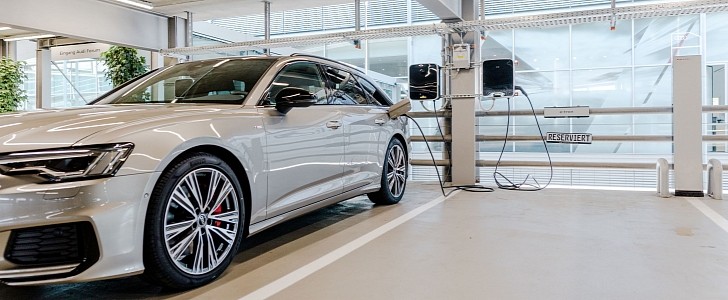Audi is making history at its site in Neckarsulm. After recently having expanded the plant and introduced new technologies to support the production of the Audi R8 high-performance sports car and all-electric Audi e-tron GT, the company is also focusing on making the site carbon-neutral by 2025.
The Audi site in Neckarsulm is one of those venerable European plants that have a long history behind them. In this case, over 100 years of manufacturing vehicles. The 1 million square-meter (10 million square feet) plant is where the Audi A4, Audi A5 Cabriolet, Audi A6, Audi A7 and Audi A8 are made.
The plant was expanded with the addition of 30 hectares almost 4 miles away, in the Bollinger Hoffe industrial park. This is where the Audi R8 and Audi e-tron GT are being produced. According to Audi, producing an all-electric model and a combustion engine model on a shared assembly line is an innovative feature that sets apart the Volkswagen Group.
Besides the new production technologies that were introduced for the development of the new electric model, Audi also focuses on sustainability measures that will lead to turning the Neckarsulm facility into a carbon-neutral factory, in less than 5 years. Even since last year, green power has been sourced across the entire site. One of the objectives is to no longer use water from the Neckar river, which is why at the moment, a closed water cycle is being tested at a pilot plant.
Another pilot project has to do with plastic waste and turning it into assembly aids, with the help of 3D printing. According to Achim Diehlmann, head of corporate environmental protection at Neckarsulm, the various environmental measures were organized on hierarchal levels.
Energy efficiency, self-supply, dealing with carbon emissions that can’t be avoided (such as shipments to and from the site) are just some of the key areas for sustainability.
The plant was expanded with the addition of 30 hectares almost 4 miles away, in the Bollinger Hoffe industrial park. This is where the Audi R8 and Audi e-tron GT are being produced. According to Audi, producing an all-electric model and a combustion engine model on a shared assembly line is an innovative feature that sets apart the Volkswagen Group.
Besides the new production technologies that were introduced for the development of the new electric model, Audi also focuses on sustainability measures that will lead to turning the Neckarsulm facility into a carbon-neutral factory, in less than 5 years. Even since last year, green power has been sourced across the entire site. One of the objectives is to no longer use water from the Neckar river, which is why at the moment, a closed water cycle is being tested at a pilot plant.
Another pilot project has to do with plastic waste and turning it into assembly aids, with the help of 3D printing. According to Achim Diehlmann, head of corporate environmental protection at Neckarsulm, the various environmental measures were organized on hierarchal levels.
Energy efficiency, self-supply, dealing with carbon emissions that can’t be avoided (such as shipments to and from the site) are just some of the key areas for sustainability.








